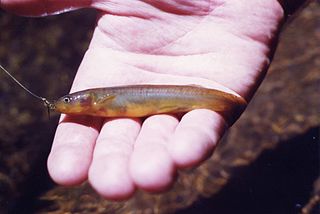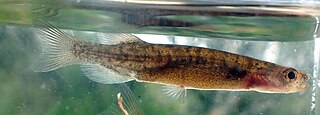
The Galaxiidae are a family of mostly small freshwater fish in the Southern Hemisphere. The majority live in Southern Australia or New Zealand, but some are found in South Africa, southern South America, Lord Howe Island, New Caledonia, and the Falkland Islands. One galaxiid species, the common galaxias, is probably the most widely naturally distributed freshwater fish in the Southern Hemisphere. They are coolwater species, found in temperate latitudes, with only one species known from subtropical habitats. Many specialise in living in cold, high-altitude upland rivers, streams, and lakes.

The climbing galaxias or kōaro is a fish of the family Galaxiidae found in Australia, New Zealand, and nearby islands. The name climbing galaxias is used in Australia, and koaro or kōaro in New Zealand. Further vernacular names include short-finned galaxias, broad-finned galaxias, Cox's mountain galaxias, and Pieman galaxias.

The mountain galaxias is a species complex of freshwater galaxiid fish found all over southeast Australia.

The common galaxias or inanga is a very widespread Southern Hemisphere fish in the family Galaxiidae. It is a slim, narrow fish with a forked tail and a mottled, spotty pattern, typically about 10 cm (4 in) long when fully grown. It lives in fresh water, but spawns at river mouths and spends the first six months of its life at sea, returning en masse in spring. Its vernacular names include cowfish, jollytail, common jollytail, eel gudgeon, inaka, native trout, pulangi, puye, slippery tarki, spotted minnow, Falklands minnow and whitebait.
Galaxias fuscus, the barred galaxias, is a galaxiid of the genus Galaxias, a member of the Mountain Galaxias species complex group of freshwater fish, found in Australia.

The Chatham mudfish, formerly known as the Chathams galaxias, is a galaxiid fish endemic to two small, peaty lakes in southern Chatham Island, New Zealand.

The banded kōkopu is a galaxiid of the genus Galaxias, found only in New Zealand, including the Chatham and Stewart / Rakiura islands. It commonly grows to 20–25 cm, but has been recorded growing to around 30 cm. Juvenile banded kōkopu are good climbers and can climb up waterfalls and other vertical surfaces by moving into the splash zone and wriggling up the surface, using the water surface tension and their large downturned fins for grip.

The shortjaw kōkopu is a galaxiid ray-finned fish, endemic to New Zealand. They are large, scaleless fish which inhabit stable pools in cascading, bouldery streams with forest cover. Shortjaw kōkopu are amphidromous, with the fry going to sea after hatching, and returning as juveniles to fresh water where they grow to adulthood. They may grow to a maximum of 350 mm (14 in) in total length, but more commonly reach 150–200 mm (5.9–7.9 in).

The giant kōkopu is a threatened species of ray-finned fish in the genus Galaxias, found only in New Zealand. It can reach up to 58 cm (23 in) in length and 2.7 kg (6.0 lb) in weight, making it the largest species in the family Galaxiidae. It is a mainly lowland species, commonly found in slow-flowing streams, wetlands, lakes, and lagoons. Most populations have an amphidromous life cycle, with larvae going to sea soon after hatching and returning about four months later as small juveniles, 4.5–5 cm (1.8–2.0 in). Juvenile giant kōkopu form a small part of the annual whitebait catch.

The dwarf inanga is a galaxiid of the genus Galaxias, found in the North Island of New Zealand.
The longjawed galaxias is a galaxiid of the genus Galaxias, found only in rivers and streams at mid to high altitudes on the eastern side of the Southern Alps in the South Island of New Zealand. It grows to a length of up to 9 cm.

The lowland longjaw galaxias is a galaxiid of the genus Galaxias, found only in the South Island of New Zealand, in the Kauru River, a tributary of the Kakanui River in north Otago, and in parts of the upper Waitaki catchment. It grows to a length of up to 7 cm.

The Central Otago roundhead galaxias is a galaxiid of the genus Galaxias, found only in the Taieri and Clutha catchments in Otago, New Zealand. It grows to a length of up to 13 cm (5.1 in).

The dusky galaxias is a galaxiid of the genus Galaxias, found only in the Taieri and Clutha catchments in Otago, New Zealand.

The alpine river galaxias is a galaxiid of the genus Galaxias, found only in mid to high elevation streams flowing from the Southern Alps of New Zealand. It grows to a length of up to 11 cm.

Gollum galaxias is a galaxiid of the genus Galaxias, found only in southern temperate regions in New Zealand. The species is widespread in rivers throughout the Southland Plains as well as the Von River and Nevis River tributaries of the Clutha River The species is found on Stewart Island / Rakiura, and throughout the Catlins.

Galaxias divergens, common name dwarf galaxias, is a galaxiid of the genus Galaxias, found only in the lower North Island and upper South Island of New Zealand. It grows to a length of up to 9 cm.

Galaxias is a genus of small freshwater fish in the family Galaxiidae, and are frequently referred to as the galaxiids. These highly adaptable fish are typically found at temperate latitudes across the Southern Hemisphere.
Galaxias is a genus of galaxiid fishes.

Oteake Conservation Park is a protected area in the Waitaki District and Otago Region of New Zealand's South Island. Oteake or place of the ake is named by Kāi Tahu iwi for the ake ake, a shrub daisy found throughout the park.


















